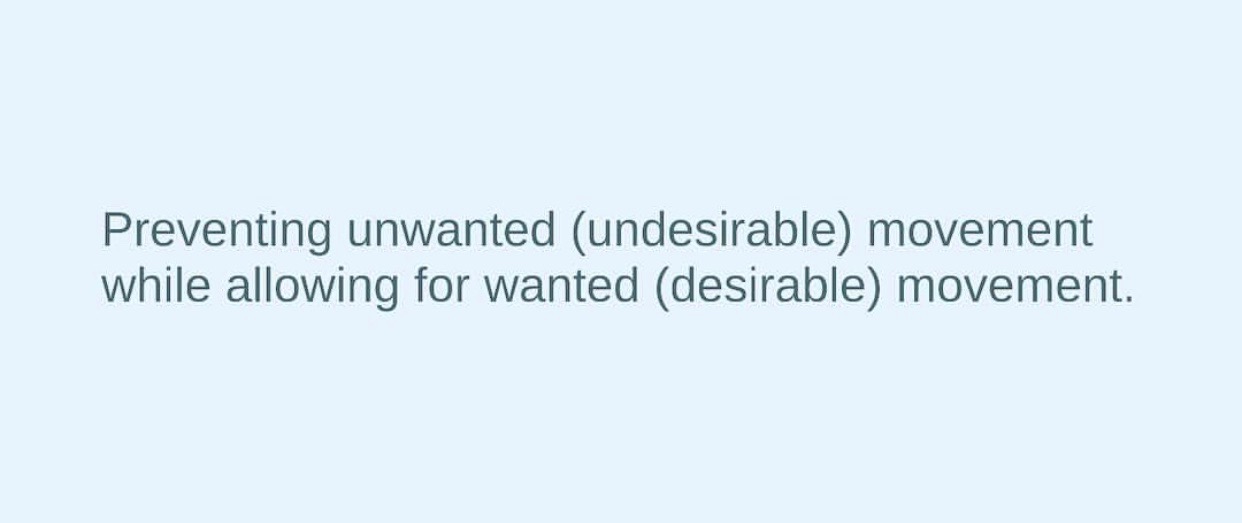What Really Is The Key to Pain Free Shoulders?: Flexibility, Mobility and Stability
2019-06-24
Jessica Bento, Physical Therapist (Creator DVRT Restoration, DVRT Shoulder Course, and Pelvic Control)

When it came to helping people that I would see in the clinic all the time, it usually revolved around the “big three of injury”. That was shoulders, knees, and low backs. While the actual issues would vary, inevitably it seemed like we came back to the concepts of flexibility, mobility, and stability. I may not always know what caused the injury in the first place, but often I was left with patients that now had to address all three issues at once.
Flexibility, mobility, and stability, these seem to be really hot topics right now in the fitness industry and It seems like all these terms tend to get lumped together and their meaning becomes lost. They are all not the same, in fact, they have quite different meanings but have strong overlap to one another, as that is where I think people get confused. If we don’t understand the real intent of what we are doing then we are truly guessing in how we are trying to solve issues for people.

Don’t worry, I’ll explain what the differences are and how it will impact your focus during training.
Let’s start with flexibility, when we tend to think of people that are flexible my mind goes to gymnasts who are capable of contorting their bodies in many different ways. That’s what I picture when I hear the words flexible. What does it mean to be flexible? Flexibility is the absolute range of motion in a joint or system of joints, and the length of the muscle the crosses the joint involved. So back to the gymnast, their ability to perform something such as the splits is due to flexibility of the lower quarter. It does correlate to mobility which we will discuss in a second but has nothing to do with strength, balance and or coordination. That is because flexibility doesn’t necessarily reflect what is happening with the nervous system.
So what is mobility? Isn’t it the same as being flexible? Mobility is looking at the joint and the degree to which the area where the two bones of that joint meet is allowed to move before being restricted by surrounding tissue such as muscle, tendons and ligaments. Mobility is the motion around a joint. Think of young kids that W sit, their hip mobility tends to be greater than when we are adults. Mobility tends to be more neurologically driven and sensitive to movement than just flexibility.

Movement is often impacted by what your nervous system perceives as safe or risky movements by your body.
Lastly we have the hot topic nowadays of stability. Stability is the ability to maintain control of a joint movement or position. It is achieved by the coordination of actions of surrounding tissues and the neuromuscular system. Josh uses a much simpler quote from Dr. Brandon Marcello, “allowing wanted movement while resisting unwanted movement.” This can refer to a specific joint or whole body. What you will find that the answer to improving stability of a joint WILL have a lot do with what the whole body is doing as well.

So why all this talk? Well, I want to talk shoulders, and one of the features of a normal shoulder is that the glenohumeral joint (the ball and socket joint between the upper arm bone and the shoulder blade), is very stable spite the vast range of motion available to the joint. Yet this joint tends to be the one joint I see so many issues with. People saying they can’t go overhead with weights, pain with movements, limited range of motion and so forth. So why if it has all these capabilities do people have so many issues?
I would like to believe its stability that is the issue, the lack of mobility you see if really an issue with stability. Though it might appear outwardly as if range of motion is lost. It’s that the individual has lost the ability to control the joint. When were are talking shoulders there is so much that can be affecting the joint such as the cervical spine, thoracic spine, posture and prolong positions through the day.

The popular Joint by Joint approach by Mike Boyle and Gray Cook can help us see that shoulder restrictions could be related to issues in other parts of the body from the hands to the hips, all the way to the feet.
Research has pointed to as much. This quote from a study on shoulder rehabilitation mentions the following, “…The prescription of therapeutic exercises that address both shoulder weakness and core dysfunction simultaneously, may serve as a transitional program between the initial shoulder rehabilitation program and the terminal sport specific functional exercises. Several studies have found an association between a decreased stability and a higher risk of sustaining a low back or knee injury.”
So how do we teach stability of the shoulder joint, in a way that can re train and re activate our ability to control the movement better? Stretch? Stretch? Stretch? No…remember I said that it is my belief that most shoulder issues are stability issues vs flexibility and mobility issues. Stretching may make you feel good, but it is rarely solving the issue by itself.
The shoulder is very connected to the core, hips and feet. So the below examples can help quite a bit in instability, improving not only the shoulders but the hips too!
View this post on Instagram
Half kneeling press outs with specific intent can go a long ways in creating success!
This may seem odd as most think going overhead when you have upper body limitations would be impossible. However, when we create stability from the ground up we use tension, we often see that people can get into new ranges of motion pain free. Another study looking at the force and shoulder health of throwing athletes found, “Limitations in throwing velocity, pitch control, and bat swing speed may be secondary to decreased mobility and strength within the proximal kinetic chain, which must harness power from the lower extremities and core.” You can see trying to make the shoulder the focus is missing the larger picture of our how our body actually performs. How can we use these ideas in practical ways though?
Going half kneeling we can focus on the hips and driving into our feet which connect our core from the ground up, using the glutes to help stabilize the levels which is actually part of the platform for the shoulders. Being half kneeling gives us a slightly unstable environment where we can quickly identify loss of stability and connection in the body. Using feedback mechanisms like bands can be simple and powerful ways to ensure our success. The band gives us feedback to drive into the ground and to activate the glutes, by not squeezing them, but using the feet.
Using the grip and pulling apart the Ultimate Sandbag we use this connection of gip, shoulders, lats and core. Stabilizing this chain allows us to see the nervous system provide greater stability and mobility. These motions combine myofascial stretching along with loaded movement that cements patterns and gives feedback and connection form all the relevant chains of the body.

The difference of creating specific tension changes everything we do or don’t get from our exercises.
How do we even get overhead though? Don’t we have “bad” shoulders. I was a bit skeptical too as Josh would break down these drills and concepts. They made sense, but why would they be so profound? Then I actually tried them and I was amazed how when we brought science alive how it created such instant and powerful effects to movement. Creating that tension in the way I just described can instantly change one’s mobility and just as importantly how their shoulders feel during movement.
This is why I love DVRT and hope we continue to bring you real solutions to common issues so that you can really bring your strength to life! Check out these 3 examples so you can see how practical better mobility can be and how you can instantly improve your strength and movement!
Don’t miss 30% off physical therapist, Jessica Bento’s new DVRT Rx Shoulder Program. Detailed information about better understanding the shoulder, common myths, practical screens, and 6 months worth of training to help not only your shoulder, but your whole body become stronger and more resilient. Not only will you get 30% off this week, you will ALSO get our DVRT Shoulder Webinar for FREE! Just use code “shoulder” HERE
© 2024 Ultimate Sandbag Training. Site by Jennifer Web Design.







